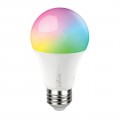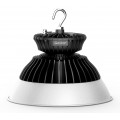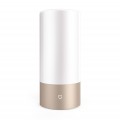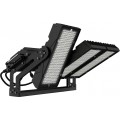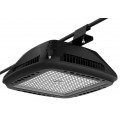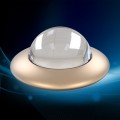Light emitting diodes (LEDs) are generally fabricated using semiconducting material doped with impurities to create a P-N junction. When electrical potential (voltage) is applied to the P-N junction current flows through the junction. When a bias is applied across the doped layers, holes and electrons are injected into the active layer where they releases energy in the form of light (photon, radiant energy) and heat (phonon, thermal energy). Despite the remarkable improvement in energy efficiency over more traditional light sources, LED light sources still convert between 50 to 80% of the power they are fed into heat. On the other hand, LED luminaires are highly temperature-sensitive in both performance and reliability as opposed to incandescent or halogen filaments. Higher than the LED junction temperature, the LED's forward voltage will increase, thereby leading to elevated power consumption. Also, its luminous output will fall correspondingly and its reliability and lifespan will also be negatively impacted.
Driving the LED hard in high ambient temperatures may contribute to overheating of the LED package, ending up with poor performance and inevitably resulting in device failure. Typical problems attributable to heating of the semiconductor junction and adjoining structure are: 1) failures caused by such occurrences as non-homogenous distribution of the current density over the junction ("current crowding"), which creates a local hot spot in the diode junction resulting in early failure as a consequence of thermal runaway; 2) color shift and reduced light output in short term, while the long-term effects are rapid lumen depreciation and shortened useful life; 3) nucleation and growth of dislocations in the active region of the diode in which the radiative recombination occurs as a result of presence of an existing defect in the semiconductor crystalline structure and which is sped up by heat; 4) degradation of materials applied to the LED, which include phosphor or encapsulate, resulting in decrease in efficiency and changes in output color; and 5) electromigration of metal atoms at the metallization layers of the diode leading to growth of conductive "whiskers" and premature failure. This is not a complete list of the undesired effects caused by raised temperatures; it is provided herein just as a list of exemplary effects.
The heat is frequently measured by a "junction temperature", i.e., the temperature of the semiconductor junction of the LED. Because LED performance is associated with junction temperature it is desirable to transfer heat from the LED package in the shortest time. For that reason, adequate heat-sinking or cooling is necessary to maintain a long lifetime for the LED, which is particularly important in applications where the LED must operate over a range of temperatures. As a way to provide a satisfactory lifetime, for example, an L70 of at least 25,000 hours, it is advantageous to make certain that the junction temperature should not be higher than 85°C. In an effort to ensure a junction temperature that is not above 85°C, a variety of heat sinking schemes have been designed to dissipate at least some of the heat that is generated by the LED. Heat produced within the LEDs and phosphor material in typical solid state light sources is transmitted via conduction means to large appended heat sinks usually constructed from aluminum or copper. The temperature variance between the LED junction and heat sink can be 40°C to 50°C. The larger the heat sink, the larger the temperature drop between the LED junction and the surface of the heat sink fins. Because of this, heat pipes and active cooling is utilized to either reduce the temperature drop or increase the convective cooling so that a smaller heat sink volume can be used.
Thermal management relates to a system's ability to draw heat away from an LED. There are a wide range of approaches that have been utilized to dissipate heat from packaged electronic devices. Generally, LED cooling systems depend primarily on convective mechanisms to get rid of heat. Heat convection describes heat transport by an external source, such as a fan. The application of passive thermally conductive materials that absorb the heat and slowly increase in temperature might be extremely impractical for extended time thermal dissipation. Passive cooling technology, such as a heat sink thermally assembled to a luminaire, is often used to transfer heat from a solid material to a fluid medium such as, for example, air. Heat sinks are components or assemblies manufactured to deliver energy away from LEDs that generate heat. A passive heat sink typically consists of a metal structure of bigger physical volume than the heat source element in physical contact with the heat source directly or through supplemental material layers to form a thermal conduction pathway. These components may also transfer heat to other elements or the encircling environment, for example, by conduction, convection, or radiation processes. The heat sinks may comprise channels, fins or other geometries to increase surface area. The fins have a substantial surface area to dissipate heat, which boosts dissipation of heat from the LED lamp, in so doing increasing the volume of power that can be applied to the LED lamp with no damage to the LED lamp. Another passive tactics of providing for heat removal includes mounting the electronic device on a circuit board which is made to improve thermal conductivity.
Other methods of heat removal which have been applied include active heat removal solutions. One particular active heat removal solution involves the utilization of an electrical direct current fan. Another active method of heat removal incorporates the use of a Peltier cooler which is an electrical device that operates as a heat pump whereby heat is transferred from one side to the other when current is supplied to the cooler. Other thermal strategies for equipment which use active optical elements have utilized heat pipes or other devices depending on principles of a thermal conductivity and phase transition heat transfer mechanism. A heat pipe or the like can be employed alone or in conjunction with a heat sink and/or an active cooling element. Specialty materials known as "thermal grease", "thermal adhesives", "thermal pads" or other filled or composite materials or structures may be included in modules or fixtures to bridge interfaces to increase thermal conduction.




















